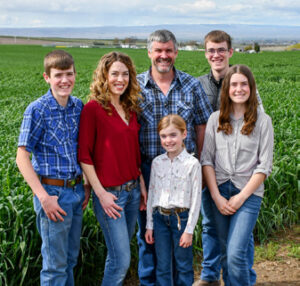On their dairy farm in Yakima County, Washington, Karen, and Jason Sheehan raise their children in the same farming way of life in which they were raised. But they conduct their day-to-day operations with an eye toward the future. Irrigation Leader spoke with Karen and Jason Sheehan about using water wisely and collaborating with other water users to implement the Yakima Basin Integrated Plan (YBIP).
Irrigation Leader: Please tell us about your background.
Karen Sheehan: Jason and I both grew up on dairy farms. We now live on the farm in Washington State where I grew up. I am originally from California. I’m a fourth-generation dairy farmer, and our kids are heavily involved in agriculture, too.
Irrigation Leader: Where in California is your family from?
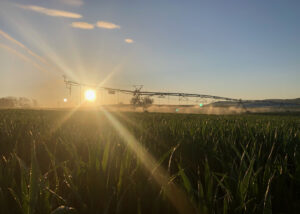
Karen Sheehan: My parents started in the dairy business in Turlock, California. They ended up coming to Washington State, where they rented a place and then bought a dairy and remodeled it. Eventually, my parents were able to move to the farm where we live now. Besides a home, there was nothing here but bare ground. They built the place from the ground up.
Irrigation Leader: Jason, where is your family from?
Jason Sheehan: My family still operates a couple of dairy farms in southeastern Minnesota. Right now, my three uncles and two cousins are running the farm. They are still milking 300 cows and farming 800–1,000 acres. We went back for a couple of years, but it ended up working better to move out here. Like Karen, I’ve been a dairy farmer all my life.
Irrigation Leader: How many cows are you running right now?
Jason Sheehan: We’re milking a little over 3,000 cows. We also have dry cows and heifers, so we have around 6,000 animals in total on two sites. We milk three times a day, 24/7, 365, including all holidays, regardless of the weather.
Irrigation Leader: Are they all Holsteins?
Jason Sheehan: For the most part. Our younger son has decided that he should have one of all seven breeds of dairy. He has a Holstein, a Red Holstein, a Jersey, a Brown Swiss, an Ayrshire, a Milking Shorthorn, and a Guernsey.
Irrigation Leader: How much rain do you normally get?
Karen Sheehan: About 6–9 inches a year, so irrigation is critical for the operation. Really, we live in a desert.
Irrigation Leader: We’ve heard from the Department of Ecology that yours is one of the best examples of a forward-thinking dairy that is doing various things to comply with environmental regulations.
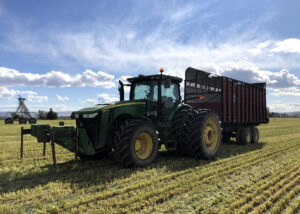
Jason Sheehan: We’re one of a handful of dairies in the Yakima Valley that actually has a National Pollutant Discharge Elimination System Concentrated Animal Feeding Operation permit. It requires a pretty strict management process for nutrients.
Irrigation Leader: Let’s talk about some of the things that you’re doing. We have heard that you use water five times. Can you explain that?
Karen Sheehan: Water comes out of the ground from the well at 60 degrees. We immediately use it to cool milk, which comes out of the cow at 100 degrees, the cow’s body temperature. After that, the
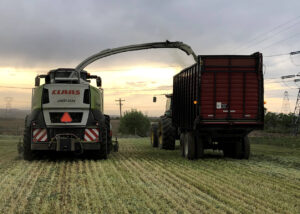
water is given to the animals to drink and used to cool the cows. In the summers, we run sprinklers over the animals to cool them and keep them comfortable, which keeps our milk production up. After the cows drink the water and expel it as urine or manure, we recycle it in our flush system. Our flush system continuously cleans out the alleys where the cows are standing behind the feed bunks. That goes into a lagoon and is separated into liquids and solids. The liquids are then put on our fields as irrigation and fertilizer.
Jason Sheehan: That process helps build organic matter. The organic matter was pretty low in the soil before we got here. By applying organic nitrogen and organic fertilizers, we’ve raised the proportion of organic matter in the soil. Higher organic matter means greater water retention. Then, when there is drought, you actually need less water to irrigate your crops. It’s an amazing cycle, and water plays an integral role throughout it.
Karen Sheehan: I always like to say we do more with less. That’s a big goal of our dairy.
Irrigation Leader: Please tell us about the importance of irrigation to your operation.
Jason Sheehan: Irrigation water is your number 1 resource when you’re growing a crop. All of us know that we can use it efficiently and train ourselves to use only what we need. There are some things that we know about growing crops in the dairy industry, such as that we don’t want to be pushing nutrients past the 2-foot root zone. We use real-time irrigation probes to make sure that we water enough to maximize crop yield but not so much that we push nutrients past that root zone.
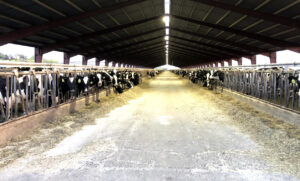

We’ve really evolved in our use of irrigation water over the last 20 years. When Karen and I first got here, everything was rill and furrow irrigated. We wanted to double-crop triticale and corn to use as many nutrients as we could. We soon figured out that you can’t do that efficiently while rill irrigating, so we started switching to pivot irrigation with overhead sprinklers. We had the sprinklers on top of the pivot before we found out how much water evaporates. Then, we switched to using drops on the pivot and had to integrate irrigation monitoring. We had problems at first, but now we’ve gotten to the point at which I can turn on any of our pivots from my phone. I can change the speed, I can look at the sensors in the field to find out how we’re doing on water, and I can communicate with my employees to make sure we’re not over- or underwatering. We have satellite imagery that comes weekly, showing us where we’re doing a good job with biomass in the field and crop yields and allowing us to see if there are issues with the sprinkler package. We also have yield monitoring on our forage harvester, which allows us to use variable-rate seeding, fertilizing, and manure application based on the needs of different areas of the field.
With those advancements in irrigation, we have also changed our approach to tilling. When we got here, we were overplowing and washing the soil away. Along with the soil, you wash away the phosphorus and potassium, and you especially don’t want phosphorus in your lakes and streams. Now, we’ve switched to minimum tillage. The majority of what we do when we take triticale on is no-till. It’s a completely different and more advanced way of farming.
Irrigation Leader: What kind of pivot package do you use?
Jason Sheehan: All our pivots are Valley center pivots. All our pivots have drops and pressure regulators to ensure that we’re applying water evenly throughout the field.
Irrigation Leader: Jason, you are on the board of directors for Roza Irrigation District. Why did you decide to get involved?
Jason Sheehan: A past board member contacted me because he felt that we needed to have a broad representation of farming styles on the board. A majority of the Roza farmers grow permanent crops, such as apples, cherries, grapes and juice grapes, and hops. There was no one representing row crops on the board. They caught me at a weak moment, and I said yes.
Irrigation Leader: Please tell us about the YBIP.
Jason Sheehan: The beauty of the YBIP, and what’s so impressive about it, is that it has brought all the stakeholders to the table—the farmers, the tribes, the irrigation districts, the fish and wildlife interests, Ecology, the Bureau of Reclamation, and other people dealing with water rights. As we deal with climate change and other issues, we’re trying to find a solution to make sure that all parties have a say in how water is used in our area. Fish are important to all of us, farming is important to all of us, and the environment is important to all of us. It is really one of the neatest synergies I’ve seen in a long time in the West. We understand that the world is changing and that to survive in the future, we can’t keep doing things the way we’ve always done them. An example is our own farm operation, which has changed so much in 20 years. We may not want to believe in climate change, but the fact is that if we get low snowpack, we’ve got issues, not just for farming but for fish. When you get everybody involved in working toward solutions, the synergies add up to some great outcomes. Now, it is just a matter of moving forward to fund these projects and make sure we keep our eye on the goal.
Irrigation Leader: What is your message to your congressional delegation and to our readers about the YBIP? What should they know about it?
Jason Sheehan: We all sat down and figured out how to collaborate and come up with a plan for the future that we hope will be successful. If you look across the rest of the West, there are people who haven’t done this, and they are running into some big issues regarding how to divvy up the water. We’d rather do it as stakeholders at a table where we can communicate with each other than let it get to the court system and let someone else decide, because there, in the end, no one wins.
Irrigation Leader: Karen, you’re involved in Washington’s AgForestry Leadership Program. Please tell a little bit about that and why you got involved.
Karen Sheehan: I had always been involved in leadership positions until we started having children. I decided it was time to get more involved again. In the program, we focus on leadership in agriculture and forestry, and we learn how to communicate and collaborate with others. The program encourages us to inspire others and serve in our local communities and states. It’s a great program, and I’ve learned a lot. The relationships and networks that I’ve built have been important, and it has been incredible to learn about the different industries in this state. I’m excited about next year, when we’ll continue to work on and present a public policy project.
Irrigation Leader: It’s a great program, and I hope that more folks like you get involved to keep it going. On top of that, your family is also involved in 4-H and Future Farmers of America (FFA).
Karen Sheehan: Yes. We have four kids, and all of them have been in 4‑H since they were very young; a couple are now in FFA. Our four children show swine and dairy. Our youngest is into horses, so we have a horse now. The girls also sew and bake and do other sorts of projects. It is a great program that teaches kids a lot of good life fundamentals. Both Jason and I were involved in 4‑H growing up, and we want to make sure that our kids have that same experience. We are also involved in the local county fair. We are superintendents of the dairy barn at the Yakima Valley Fair and Rodeo. That’s a great way to stay connected with dairy, youth, and our community.

Irrigation Leader: Is there anything you would like to add?
Jason Sheehan: I hope to make people aware of how important agriculture is. To understand that, just look around the world and see the fear of food shortages resulting from what’s going on in Ukraine. We’ve got some huge blessings in this country, including the ability to grow the amount of food we do. A lot of people take their food sources for granted. We want to help them understand just how much hard work, planning, preparation, and adaptation are required to grow food. We deal not only with nature but with a shrinking labor force and increased costs and environmental regulations. Yet somehow, year in and year out, farmers continue to bring food to the table. People don’t always understand what it takes to get it there. Irrigation water in the West is a prime example of how important it is to work with everyone and to make sure we don’t tilt the tables too far one way or the other. Sufficient water can and should be provided to both farms and the environment, and the two uses can complement each other. To enable us to keep providing food and keep our ecosystems healthy, we need to keep the supply balanced.
Karen and Jason Sheehan are dairy farmers in Yakima County, Washington. They can be contacted at jkdairy2003@gmail.com.
